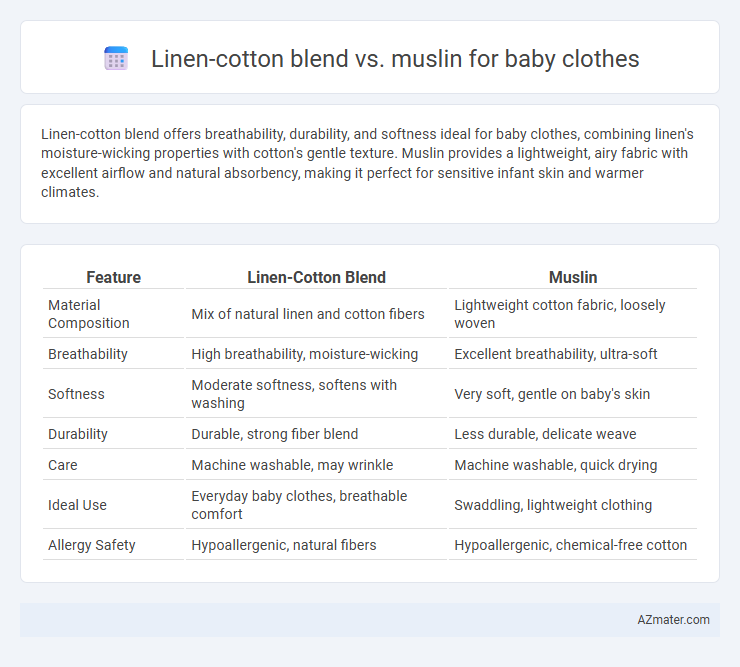Linen-cotton blend offers breathability, durability, and softness ideal for baby clothes, combining linen's moisture-wicking properties with cotton's gentle texture. Muslin provides a lightweight, airy fabric with excellent airflow and natural absorbency, making it perfect for sensitive infant skin and warmer climates.
Table of Comparison
| Feature | Linen-Cotton Blend | Muslin |
|---|---|---|
| Material Composition | Mix of natural linen and cotton fibers | Lightweight cotton fabric, loosely woven |
| Breathability | High breathability, moisture-wicking | Excellent breathability, ultra-soft |
| Softness | Moderate softness, softens with washing | Very soft, gentle on baby's skin |
| Durability | Durable, strong fiber blend | Less durable, delicate weave |
| Care | Machine washable, may wrinkle | Machine washable, quick drying |
| Ideal Use | Everyday baby clothes, breathable comfort | Swaddling, lightweight clothing |
| Allergy Safety | Hypoallergenic, natural fibers | Hypoallergenic, chemical-free cotton |
Introduction to Baby Clothing Fabrics
Linen-cotton blends offer breathability, durability, and natural softness, making them ideal for baby clothes that require gentle skin contact and temperature regulation. Muslin is a lightweight, loosely woven cotton fabric known for its exceptional softness and breathability, often used in swaddles and summer clothing due to its moisture-wicking properties. Both fabrics provide comfort and ease of care, but linen-cotton blends tend to be sturdier, while muslin excels in lightweight, airy wear.
What is Linen-Cotton Blend?
A linen-cotton blend combines the natural breathability and durability of linen with the softness and flexibility of cotton, making it an ideal fabric for baby clothes. This blend offers enhanced moisture-wicking properties and gentle texture, reducing skin irritation for sensitive infants. Unlike muslin, which is lightweight and loosely woven, linen-cotton blends provide a sturdier and more structured fabric while maintaining comfort and breathability.
What is Muslin?
Muslin is a lightweight, loosely woven cotton fabric known for its breathability and softness, making it ideal for baby clothes and swaddles. Unlike a linen-cotton blend that combines the durability of linen with the softness of cotton, muslin offers exceptional airflow and gentle comfort against delicate baby skin. Its natural absorbency and ease of washing make muslin a practical choice for keeping babies cool and comfortable.
Breathability and Comfort Comparison
Linen-cotton blend fabrics offer excellent breathability combined with enhanced durability, making them ideal for baby clothes by allowing air circulation while maintaining softness against sensitive skin. Muslin, known for its lightweight and airy weave, provides superior breathability and a gentle texture that ensures maximum comfort in warmer climates. Both materials prioritize comfort, but linen-cotton blends excel in moisture-wicking properties, whereas muslin stands out with its ultra-light softness and quick-drying capabilities.
Softness and Texture Differences
Linen-cotton blend fabric offers a balanced softness combined with durability, featuring a slightly textured, breathable surface ideal for baby clothes that need both comfort and resilience. Muslin is exceptionally soft and lightweight with a loose weave, providing superior breathability and a delicate, airy texture perfect for sensitive baby skin and warmer climates. While linen-cotton blends hold their shape better and offer a subtle crispness, muslin excels in softness and flexibility, making it preferable for swaddling and gentle daily wear.
Durability and Longevity
Linen-cotton blends offer superior durability and longevity for baby clothes due to the strength of linen fibers combined with the softness of cotton, providing resistance to frequent washing and wear. Muslin, while breathable and gentle on sensitive skin, tends to be less durable and may wear out faster with regular use. Choosing a linen-cotton blend ensures baby clothes maintain their shape and comfort over time, making them a more practical investment for long-term use.
Ease of Care and Washing
Linen-cotton blend fabrics offer enhanced durability and shrink resistance compared to pure muslin, making them easier to care for during frequent washing. Muslin, being lightweight and loosely woven, requires gentle handling to avoid damage or excessive shrinking, often necessitating hand washing or delicate machine cycles. Both materials benefit from cold water washes and air drying to maintain softness and shape, but linen-cotton blends typically tolerate regular machine washing with minimal wear.
Suitability for Sensitive Baby Skin
Linen-cotton blends offer excellent breathability and natural hypoallergenic properties, making them highly suitable for sensitive baby skin by reducing irritation and allowing airflow. Muslin, known for its lightweight and loosely woven texture, provides gentle softness and moisture-wicking capabilities, ideal for delicate newborn skin prone to heat rashes. Both fabrics are popular for baby clothes, but linen-cotton blends generally provide enhanced durability and temperature regulation for everyday wear.
Climate and Seasonal Considerations
Linen-cotton blend fabric offers breathable, moisture-wicking properties ideal for warmer climates, ensuring babies stay cool and comfortable during hot summers. Muslin, with its lightweight and loosely woven texture, excels in both warm and transitional seasons by providing gentle airflow while offering moderate warmth. Choosing between these materials depends on the specific seasonal conditions and desired breathability for optimal baby comfort.
Cost and Value for Parents
Linen-cotton blend baby clothes offer a durable, breathable fabric with moderate costs that provide long-term value through repeated washes and wear. Muslin, known for its ultra-soft texture and lightweight feel, often comes at a lower initial price but may wear out faster, requiring more frequent replacement. Parents seeking a balance between cost and longevity tend to favor linen-cotton blends for their resilience and comfort.

Infographic: Linen-cotton blend vs Muslin for Baby clothes
 azmater.com
azmater.com